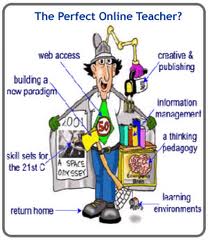Online Instruction Outsources Jobs
Imagine the perfect online teacher
Highly mobile, fully equipped, and ready at a moment’s notice to appear before a camera and teach.
Humor aside, the “perfect online teacher” is also the efficient answer to spiraling education costs. In both higher education and K-12, fulltime permanent teachers are major budget items. To reduce labor costs, both colleges and universities and K-12 districts have resorted to outsourcing.
Look at higher education. Replacing full-time tenure-line professors teaching undergraduates with part-time adjuncts–75 percent of all teaching in higher education is done by part-time instructors– and increasing the percentage of online courses in community colleges, four year regional universities, and non-elite institutions has occurred in the past two decades (CAW_portrait_2012). Although Massive Open Online Courses (MOOC) have yet to generate significant income for elite and non-elite higher education institutions, another venue for outsourcing teaching waits in the wings.
Outsourcing teaching to part-time, low-paid instructors while adding online courses is as much an efficiency move by higher education officials seeking a comparative advantage in the competitive higher education market as Toyota’s just-in-time production reduced inventory costs.
Seeking greater efficiency in instruction while driving down costs of hiring fulltime teachers also fuels K-12 public schools’ growing adoption of online instruction. Sure, there are other reasons for the expansion of online courses such as differentiating instruction and individualizing lessons. Or providing access to instruction that would be unavailable to many students–home-bound, home schooled, rural schools with limited curricula, etc. Or giving students who failed classes in high school a second and third chance to pass those courses and graduate high school.
But the surge of states and districts mandating that students must take at least one online course to graduate high school, growth of blended schools in poor communities, and for-profit cyber charters suggest that outsourcing of teaching and learning to increase efficiency and save scarce dollars is as much present in K-12 and higher education as Apple having iPhones assembled in China.
If reducing costs and increasing efficiency fuels outsourcing of teaching to adjunct faculty in higher education and online instruction in K-12, what about the bottom-line question that seldom gets asked: Is outsourcing effective? Do college or K-12 students learn as much or more from online instruction than from full-time teachers?
Even though David Brooks, New York Times pundit says: “Research into online learning suggests that it is roughly as effective as classroom learning,”–no link given in his article–that is a leap of major proportions inferred from the restrained conclusions of the only meta-analysis of distance education and online courses of which I am familiar (SRI-finalreport 2009).
Readers of this blog–see here and here– by now would have guessed that the most charitable answer is: no one knows. The far less charitable answer is: your guess is as good as mine.
When it comes to outsourcing jobs in higher education and K-12 public schools, it does not matter whether students learn from adjuncts or online courses; what matters is that dollars are saved to be spent on other items. Student outcome, again, gets sacrificed to the Holy Grail of efficiency.
This blog post has been shared by permission from the author.
Readers wishing to comment on the content are encouraged to do so via the link to the original post.
Find the original post here:
The views expressed by the blogger are not necessarily those of NEPC.


